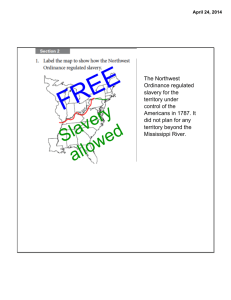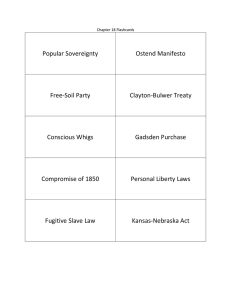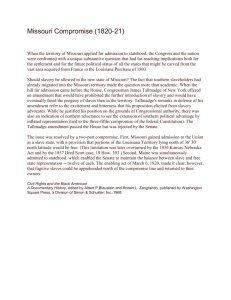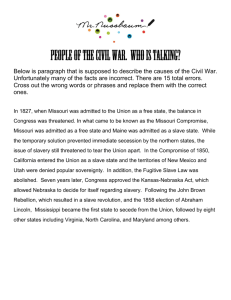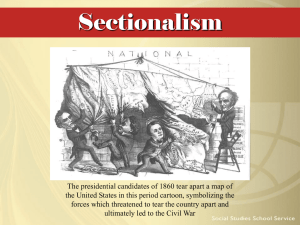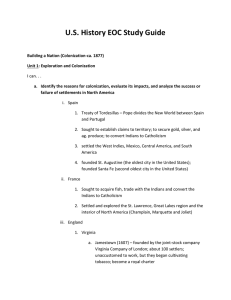MIDTERM REVIEW VA./U.S HISTORY
advertisement
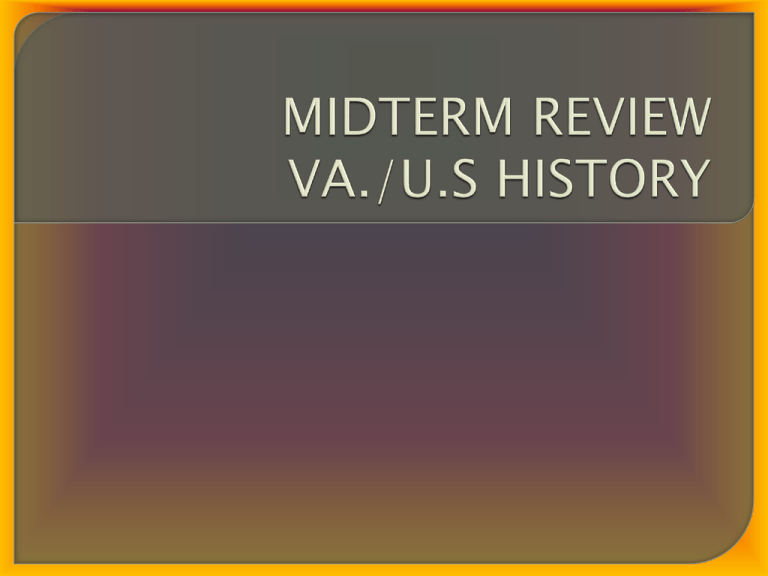
Membership in the ___ is based on population, while membership in the ___ has equal representation. House of Representatives; Senate The First Amendment to the Bill of Rights was influenced by this document written by Thomas Jefferson of Virginia. Virginia Statute for Religious Freedom The Monroe Doctrine established an imaginary boundary line around the Americas. The purpose of the line was to ban further European colonization inside the line How did the Kansas-Nebraska Act resolve the issue of slavery in the territories? Popular sovereignty would be permitted in the territories. The Compromise of 1877 accomplished THIS? Agreement reached to allow Rep. Rutherford B. Hayes to become president The forced journey of slaves from Africa to the New World was called What was affirmed in the Supreme Court case of Marbury v. Madison? The right of the Supreme Court to declare an act of Congress unconstitutional The by: Missouri Compromise is described Maine admitted as a free state, Missouri as a slave state, line of 36 30’ drawn through the Louisiana Territory After the surrender at Appomattox Court House, what did Robert E. Lee encourage Southerners to do? Admit defeat and rejoin the Union The growth of the “cotton kingdom” resulted from Eli Whitney’s invention of the cotton gin a result of Nat Turner’s rebellion whites used their fear of rebellion to justify stricter enforcement of the Slave Codes The founder of the influential antislavery newspaper, The Liberator, was William Lloyd Garrison of popular sovereignty believed that Supporters residents of a territory should decide the issue of slavery “Bloody Kansas” was the result of the the repeal of the conditions established by the Missouri Compromise the controversial Dred Scott decision, the Supreme Court declared that In because slaves were not citizens of the United States, they had no rights The term “nativism” means disliking immigrants What anti-immigrant law was passed in the 1800s? the Chinese Exclusion Act The following contributed to the growth of cities: improvements in transportation, construction of skyscrapers, large amounts of immigrants How were immigrant children affected by the creation of a public school system?. They were given help to assimilate into American society The term “suffrage” refers to the right to vote Where were immigrants in the late Nineteenth century most likely to settle? In large cities in the Northeast or Midwest What balance were the Missouri Compromise and the Compromise of 1850 designed to maintain? representation in Congress of slave and free states During the late 1800s and early 1900s, immigration laws discriminated the most against the Chinese One of the reasons for the American victory in the American Revolutionary War was Benjamin Franklin negotiated an alliance with France Which Supreme Court decision rejected efforts to limit the spread of slavery? The publication of what book inflamed anti-slavery feelings in the North? Uncle Tom’s Cabin The as Great Awakening is best described a series of religious revivals The Revolutionary War began with the Battles of Lexington and Concord What event formally ended slavery in the United States? the passage of the 13th Amendment to the Constitution Andrew Jackson’s presidency was known as the Age of Democracy The Emancipation Proclamation, issued after the battle at Antietam freed the slaves of all states in rebellion The Fourteenth Amendment guaranteed all citizens equality before the law The purchase of the Louisiana Territory doubled the sized of the United States. The Fifteenth Amendment to the U.S. Constitution gave male citizens the right to vote regardless of race, color, or former status as a slave. Later methods of depriving citizens of their 15th Amendment rights included poll taxes and literacy tests Which state was the site of Robert E. Lee’s surrender? Virginia The Articles of Confederation proved to be ineffective because they created a weak national government President Lincoln’s view of secession is best expressed by states did not have the constitutional right to leave the Union What was the most important result of the Mexican War? The US gained control of a vast amount of territory in the Southwest. The Preamble illustrates the constitutional principle that people are the true source of political power The first political parties in the United States were Federalists and DemocraticRepublicans Who is associated with the abolitionist movement as an escaped slave? Frederick Douglass Lincoln’s Second Inaugural Address remarks were meant to serve as a guide for what event? Reconstruction “It is our God-given right to spread our democracy and culture across the continent.” Manifest Destiny The territories of Oregon and Florida were acquired by America after the War of 1812 Why did seven states seceded from the Union in 1860 and 1861? to protest the election of Abraham Lincoln as President What was the event that actually started the Civil War? the bombing of Ft. Sumter Abolitionists believed that the institution of slavery should immediately cease The women’s suffrage movement began with the Seneca Falls Declaration Which region’s states seceded from the union as a result of the Election of 1860? South The chief guide for Lewis and Clark’s exploration of the Louisiana Territory was Sacajawea Fifty-five delegates from twelve states convened in Philadelphia in 1787 for the Constitutional Convention, choosing ___ to preside over the convention: George Washington He was a Northern Army general in the Civil War: Ulysses S. Grant Who directly influenced Abraham Lincoln to allow freed slaves to fight in the Civil War? Frederick Douglass What were the greatest advantages for the North during the Civil War? the large population and diversified industrial base The Emancipation Proclamation changed the goal of the Civil War for the North to ending the institution of slavery What result did the Civil War have on the South? The economy was ruined, and a large class of poor tenant farmers developed. “Jacksonian Democracy” illustrates: That Jackson’s presidency was a reaction against aristocracy; that power should not only be in the hands of the wealthy. Which statement best described the relationship between Eli Whitney’s invention of the cotton gin and slavery? Increased cotton production necessitated an increase in the number of slaves. Alexander Hamilton and Thomas Jefferson disagreed over the issue of a strong vs. weak national government and the type of economy Abraham Lincoln’s assassination impacted the South in what way? It led the way to Radical Reconstruction, which was harsher than Lincoln’s moderate plans for Reconstruction. Most settlement houses in the late 1800s offered poor city dwellers social services In the 1890s, immigration patterns shifted dramatically with most immigrants coming from southern and eastern Europe What was the federal policy regarding Native (First) Americans in the 1830s? Relocation. The First Continental Congress was the first example of the colonies coming together for a common cause Practice called whereby successful politicians reward their supporters by appointing them to office? The spoils system After the Civil War who became the leading spokesman for African Americans? Frederick Douglass American immigration patterns between 1890 and 1914 showed that most immigrants came from southern and eastern Europe The main purpose of the Jim Crow laws was to discriminate South against blacks in the Those who supported ratifying the Constitution promised to add a Bill of Rights in order to persuade the Anti-Federalists to sign the Constitution What document written by George Mason established the premise of basic human rights which cannot be violated by governments? Virginia Declaration of Rights Which statement best describes British-American relations after the French and Indian War? The colonists began to question British authority. GOOD LUCK ON YOUR MIDTERM

